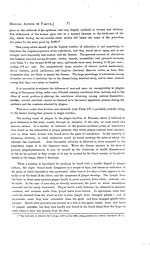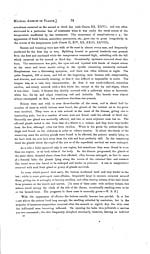Medicine - Disease > Bombay plague: being a history of the progress of plague in the Bombay presidency from September 1896 to June 1899
(102) Page 72
Download files
Individual page:
Thumbnail gallery: Grid view | List view

72 [CHAP. II.
The slow spread of plague and the immunity observed among hospital servants, nurses,
and medical men who were in constant contact with the disease, handling the sick, and
making post-mortem examinations, indicates that the germs produced in the bodies of the
sick are but little infectious to healthy persons under ordinary circumstances. The conditions
under which they become virulent will only be known when the life-history of the microbe
outside the body has been traced. Infection occurred most frequently among those
living in the same rooms with, and in constant attendance on, the sick, and there
can be little doubt but that among the poor and ignorant it was often due to the
common custom which exists of friends receiving the sputa of the sick in their hands,* and
using their hands and clothing to wipe away discharges from the patient's mouth. It is
easy to understand also that want of personal cleanliness among the friends of those affected,
and the neglect of precautions as to the disinfection of clothing soiled by the discharges and
excreta of the sick, were fruitful sources of infection.
Plague in its epidemic form, as seen in Bombay, is a malignant infectious disease,
characterized, in the majority of cases, by enlarged and painful lymphatic glands, high
fever and great prostration; and is due to the presence in the system of the plague
bacillus.
In the Bombay epidemic the period of incubation varied in duration from 36 hours,
the shortest, to ten days, the longest recorded, while in the majority of cases the period
of incubation appeared to be from four to six days.
No definite history of premonitory symptoms could be obtained, the invasion being.
as a rule, sudden and marked by severe rigors or by chills. In infants and young
children convulsions frequently ushered in the attack. In a small proportion of cases,
however, no marked onset was noticed, the patients stating that the disease began
with fever, heat of the skin and pains in the limbs. These cases usually ran a mild course
ending in recovery.
The symptoms in a typically severe case generally commenced with a well-marked
rigor, which was followed by fever, accompanied by vomiting, headache and intolerance
of light, pain in the epigastrium and frequently also in the back and limbs. Thirst was
unusually much complained of. The temperature rapidly rose to 104F. or more, reaching
its maximum, often 105F. or 106F., on the evening of the second, or, more rarely, on
the first day; occasionally a remission of 1F., or sometimes more, occurred during the day,
but with no regularity as to time. A well-marked fall in temperature of 2F. to 3F. or
more was frequently noticed on the second or third day, after which the temperature rose
again, but seldom to its former height (vide Charts III, IV, VII, X, XV, XVII, XVIII,
XIX, XX, XXII); a further fall to normal, or sub-normal, occurred between the fifth and
seventh days (vide Charts I, II, III, VII, XXII). In uncomplicated cases a fall to normal
* It seems not improbable that plague cultures grow in the ghee always present under the nails of natives who
eat curry with their hands, and that they often infect themselves from the cultures when scratching sku eruption-,
etc.
The case of Chinwal Khan reported by Surgeon-Major MaeCartie, Health Officer of the Fort of Bombay, on
the 11th January 1897.
Chinwal Khan was a fireman on the S. S. Hydaspes, which arrived from Shanghai (an uninfected port) on
Thursday, 7th January, and entered dock the same evening. He did not complain of illness during the voyage
to Bombay, and was on regular duty up to the evening of the 7th, Probably on that evening, and certainly on
Friday morning, the 8th, he visited the city. On Saturday morning, the 9th, he complained of fever and pain in
the groin, and on examination was found to be suffering from plague. The incubation period in this case was at
most 11/2 days and may have been only one day.
Nurse Joyce went to attend on Surgeon-Major Manser on the 4th January at his house. She was in good healthy
and had not been near plague cases up to that day. She nursed him from 4th to the morning of the 6th. She was
attacked by plague on the evening of the 7th, and died on the 9th January 1897.
This period cannot be accepted as finally settled, as the person attacked, a native of Bombay, may have carried
the infection with him and infected himself in Poona, where he was attacked ten day's after arriving from Bombay
and before plague had broken out in Poona.
The slow spread of plague and the immunity observed among hospital servants, nurses,
and medical men who were in constant contact with the disease, handling the sick, and
making post-mortem examinations, indicates that the germs produced in the bodies of the
sick are but little infectious to healthy persons under ordinary circumstances. The conditions
under which they become virulent will only be known when the life-history of the microbe
outside the body has been traced. Infection occurred most frequently among those
living in the same rooms with, and in constant attendance on, the sick, and there
can be little doubt but that among the poor and ignorant it was often due to the
common custom which exists of friends receiving the sputa of the sick in their hands,* and
using their hands and clothing to wipe away discharges from the patient's mouth. It is
easy to understand also that want of personal cleanliness among the friends of those affected,
and the neglect of precautions as to the disinfection of clothing soiled by the discharges and
excreta of the sick, were fruitful sources of infection.
Plague in its epidemic form, as seen in Bombay, is a malignant infectious disease,
characterized, in the majority of cases, by enlarged and painful lymphatic glands, high
fever and great prostration; and is due to the presence in the system of the plague
bacillus.
In the Bombay epidemic the period of incubation varied in duration from 36 hours,
the shortest, to ten days, the longest recorded, while in the majority of cases the period
of incubation appeared to be from four to six days.
No definite history of premonitory symptoms could be obtained, the invasion being.
as a rule, sudden and marked by severe rigors or by chills. In infants and young
children convulsions frequently ushered in the attack. In a small proportion of cases,
however, no marked onset was noticed, the patients stating that the disease began
with fever, heat of the skin and pains in the limbs. These cases usually ran a mild course
ending in recovery.
The symptoms in a typically severe case generally commenced with a well-marked
rigor, which was followed by fever, accompanied by vomiting, headache and intolerance
of light, pain in the epigastrium and frequently also in the back and limbs. Thirst was
unusually much complained of. The temperature rapidly rose to 104F. or more, reaching
its maximum, often 105F. or 106F., on the evening of the second, or, more rarely, on
the first day; occasionally a remission of 1F., or sometimes more, occurred during the day,
but with no regularity as to time. A well-marked fall in temperature of 2F. to 3F. or
more was frequently noticed on the second or third day, after which the temperature rose
again, but seldom to its former height (vide Charts III, IV, VII, X, XV, XVII, XVIII,
XIX, XX, XXII); a further fall to normal, or sub-normal, occurred between the fifth and
seventh days (vide Charts I, II, III, VII, XXII). In uncomplicated cases a fall to normal
* It seems not improbable that plague cultures grow in the ghee always present under the nails of natives who
eat curry with their hands, and that they often infect themselves from the cultures when scratching sku eruption-,
etc.
The case of Chinwal Khan reported by Surgeon-Major MaeCartie, Health Officer of the Fort of Bombay, on
the 11th January 1897.
Chinwal Khan was a fireman on the S. S. Hydaspes, which arrived from Shanghai (an uninfected port) on
Thursday, 7th January, and entered dock the same evening. He did not complain of illness during the voyage
to Bombay, and was on regular duty up to the evening of the 7th, Probably on that evening, and certainly on
Friday morning, the 8th, he visited the city. On Saturday morning, the 9th, he complained of fever and pain in
the groin, and on examination was found to be suffering from plague. The incubation period in this case was at
most 11/2 days and may have been only one day.
Nurse Joyce went to attend on Surgeon-Major Manser on the 4th January at his house. She was in good healthy
and had not been near plague cases up to that day. She nursed him from 4th to the morning of the 6th. She was
attacked by plague on the evening of the 7th, and died on the 9th January 1897.
This period cannot be accepted as finally settled, as the person attacked, a native of Bombay, may have carried
the infection with him and infected himself in Poona, where he was attacked ten day's after arriving from Bombay
and before plague had broken out in Poona.
Set display mode to: Large image | Zoom image | Transcription
Images and transcriptions on this page, including medium image downloads, may be used under the Creative Commons Attribution 4.0 International Licence unless otherwise stated. ![]()
| India Papers > Medicine - Disease > Bombay plague: being a history of the progress of plague in the Bombay presidency from September 1896 to June 1899 > (102) Page 72 |
|---|
| Permanent URL | https://digital.nls.uk/74586172 |
|---|




